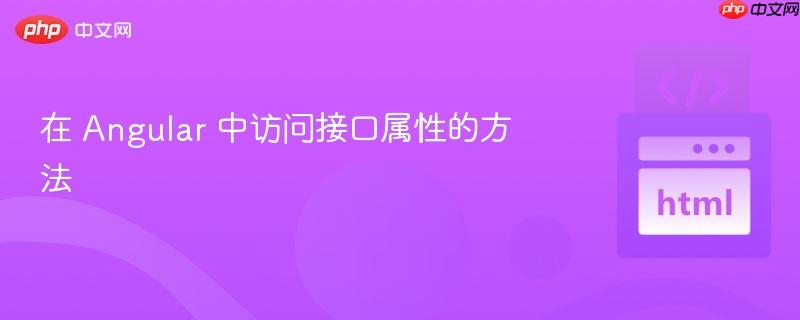
本文旨在帮助 Angular 开发者理解如何正确地访问接口中定义的属性。接口本身不存储数据,而是定义数据结构。文章将通过示例代码,详细讲解如何声明接口变量、赋值以及安全地访问接口属性,避免出现 `undefined` 错误。
在 Angular 开发中,接口 (Interface) 扮演着重要的角色,它定义了对象的结构,确保代码的类型安全和可维护性。然而,初学者经常遇到一个问题:明明定义了接口,却无法正确访问其属性,导致出现 undefined 的情况。本文将深入探讨这个问题,并提供详细的解决方案。
首先,需要明确一点:接口本身并不持有数据。它仅仅是一个类型定义,规定了对象应该包含哪些属性以及这些属性的类型。要访问接口定义的属性,必须先创建一个实现了该接口的对象,并为该对象的属性赋值。
假设我们有如下接口 IItem:
export interface IItem {
id: number;
status: any;
peso: number;
medidas: any;
quantidade: number;
tabela: {
itemTabela_id: number;
item_id: number;
vPromo: number;
vPromoData: any;
vVenda: number;
};
estoque: {
estAtual: number;
item_id: number;
};
item_linkWeb: any;
descricao: string;
fotos: Array<string>;
}要在 Angular 组件中访问 IItem 的 id 属性,我们需要:
import { Component } from '@angular/core';
import { IItem } from './item.interface'; // 假设 IItem 定义在 item.interface.ts 文件中
@Component({
selector: 'app-my-component',
templateUrl: './my-component.component.html',
styleUrls: ['./my-component.component.css']
})
export class MyComponent {
item: IItem; // 声明 IItem 类型的变量
constructor() {
// 创建实现了 IItem 接口的对象,并赋值给 item 变量
this.item = {
id: 123,
status: 'active',
peso: 1.5,
medidas: '10x20x5',
quantidade: 10,
tabela: {
itemTabela_id: 456,
item_id: 123,
vPromo: 99.99,
vPromoData: null,
vVenda: 129.99
},
estoque: {
estAtual: 50,
item_id: 123
},
item_linkWeb: null,
descricao: '示例商品',
fotos: ['image1.jpg', 'image2.jpg']
};
}
test(): void {
console.log(this.item); // 输出整个 item 对象
console.log(this.item.id); // 输出 item 对象的 id 属性值 (123)
console.log(this.item?.status); // 使用安全导航操作符,避免 status 为 null 或 undefined 时报错
}
}在上面的代码中,this.item 被赋值为一个实际的对象,因此我们可以通过 this.item.id 访问其 id 属性。
在访问接口属性时,如果该属性可能为 null 或 undefined,建议使用安全导航操作符 (?.)。它可以避免因访问 null 或 undefined 对象的属性而导致的错误。
例如:
console.log(this.item?.item_linkWeb?.linkWeb?.titulo);
如果 this.item、item_linkWeb 或 linkWeb 中任何一个为 null 或 undefined,整个表达式将返回 undefined,而不会抛出错误。
问题中的 getFreteByCep 函数始终返回 undefined,很可能是因为在调用该函数时,没有正确地将 IItem 对象作为参数传递进去。
<button (click)="getFreteByCep(cep,item)" ...>Verificar</button>
这里需要确认 item 变量在当前模板上下文中是否可用,并且是否指向一个有效的 IItem 对象。如果 getFreteByCep 函数是在循环外部调用的,那么 item 变量很可能没有被正确绑定。
解决方案:
确保 getFreteByCep 函数能够接收到正确的 IItem 对象。如果该函数需要在循环外部调用,则需要从其他地方获取 IItem 对象,并将其作为参数传递进去。例如,可以通过组件的属性来存储当前的 IItem 对象,并在 getFreteByCep 函数中使用该属性。
export class MyComponent {
currentItem: IItem;
// ...
setCurrentItem(item: IItem) {
this.currentItem = item;
}
getFreteByCep(cep: string) {
console.log(this.currentItem); // 确保 currentItem 已被正确赋值
console.log(this.currentItem?.id);
}
}<button (click)="getFreteByCep(cep)" ...>Verificar</button>
在循环中,可以使用 (click)="setCurrentItem(item)" 将当前的 IItem 对象赋值给 currentItem 属性。
理解 Angular 接口的本质,正确地声明和赋值变量,并使用安全导航操作符,是避免 undefined 错误的关键。在遇到问题时,仔细检查变量是否被正确初始化,数据是否被正确加载,以及作用域是否正确,可以帮助快速定位并解决问题。
以上就是在 Angular 中访问接口属性的方法的详细内容,更多请关注php中文网其它相关文章!

每个人都需要一台速度更快、更稳定的 PC。随着时间的推移,垃圾文件、旧注册表数据和不必要的后台进程会占用资源并降低性能。幸运的是,许多工具可以让 Windows 保持平稳运行。

Copyright 2014-2025 https://www.php.cn/ All Rights Reserved | php.cn | 湘ICP备2023035733号